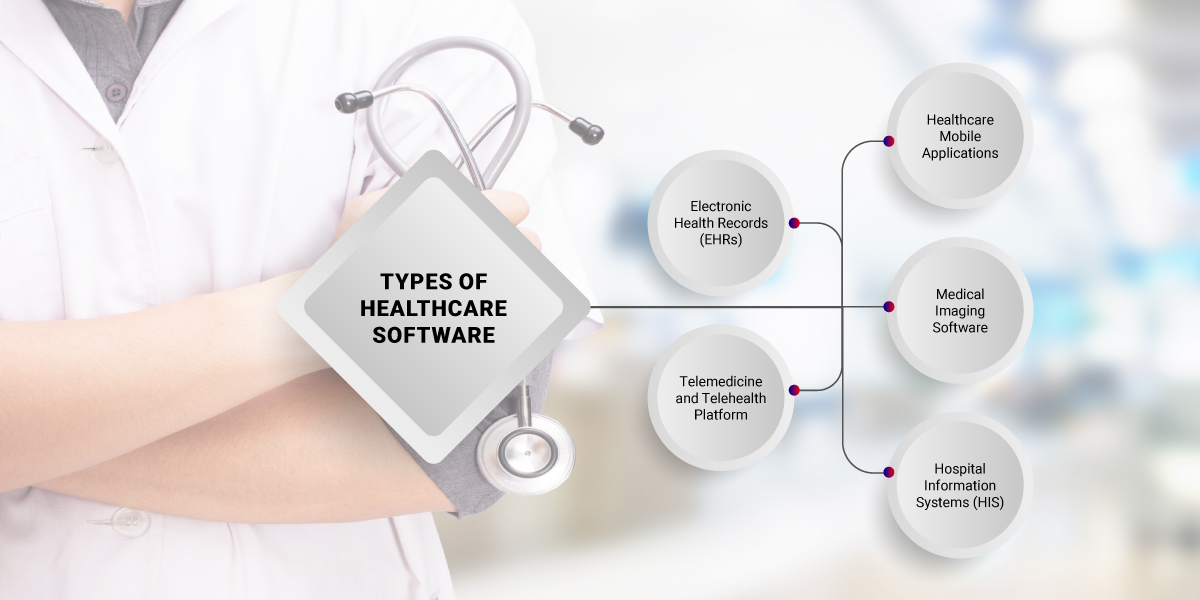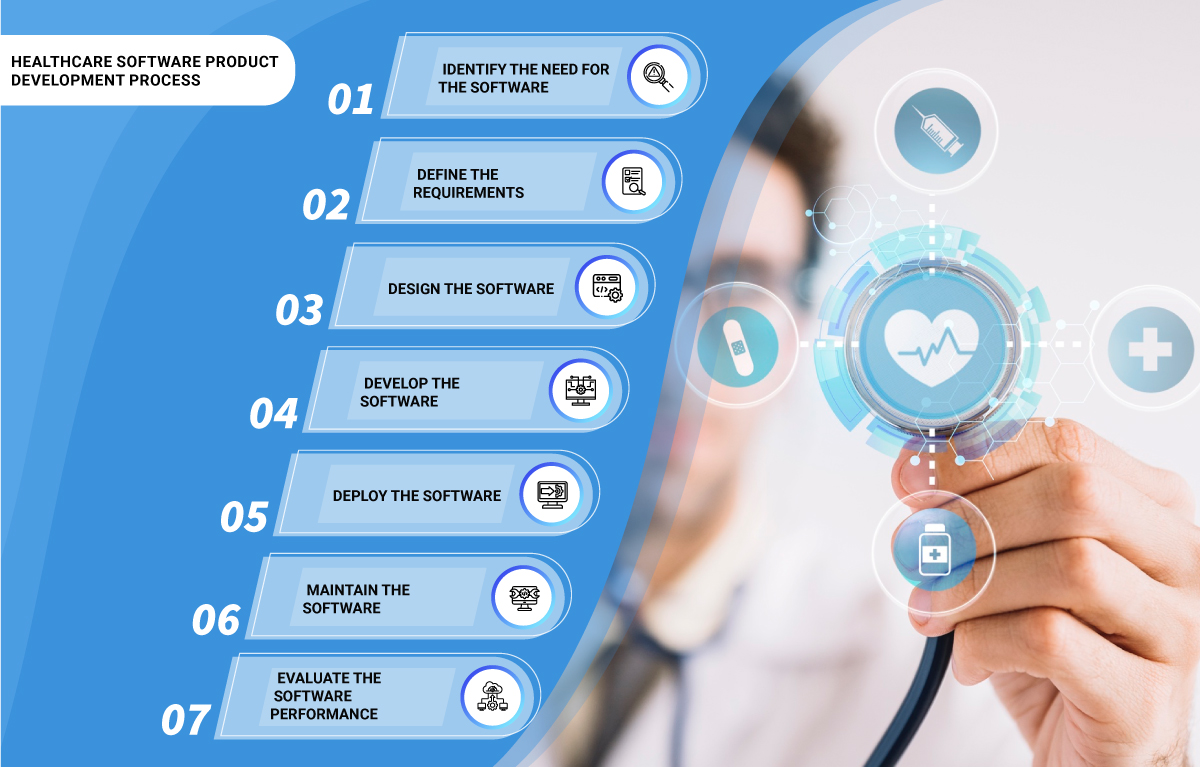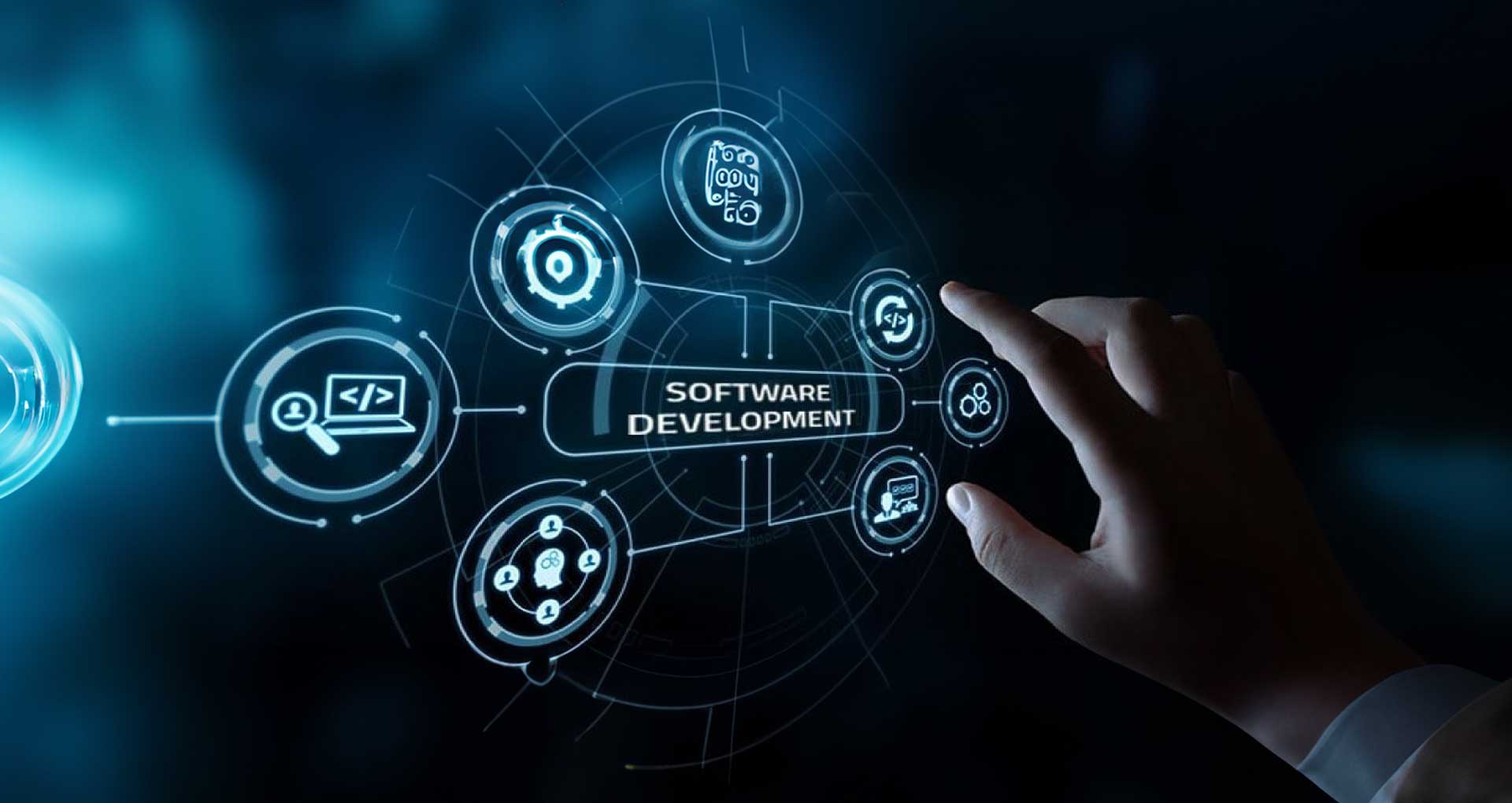Healthcare, a rapidly changing industry, seeks advanced software solutions to drive innovation and growth. Healthcare software product development aids healthcare professionals in managing patient data, scheduling appointments, monitoring medications, and utilizing data for informed decisions.
According to research, the worldwide digital health market reached $262.63 billion in 2022 and is expected to reach approximately $939.54 [1] billion by 2032. This statistic clearly indicates the growing emphasis on patient engagement, clinical robotics, incorporating gamification into healthcare, telehealth advancements, and various other areas.
In this blog, our objective is to guide you through the complex healthcare software product development process. We’ll delve into the various types of healthcare software, explore the essential features, and illustrate real-world use cases to empower you in developing a cutting-edge healthcare software product.
The Role of Healthcare Software Products in Improving Patient Care
Healthcare organizations have streamlined their operations, optimized patient outcomes, and reduced costs with the help of healthcare software. Let’s explore in detail how healthcare solutions reshape and impact patient care:
Enhanced Communication
Healthcare software facilitates improved communication between healthcare providers and patients. This enables more efficient sharing of information and allows for better care coordination.
Streamlined Processes
By automating various administrative tasks and documentation, healthcare software helps reduce the time spent on paperwork. This technological advancement has empowered healthcare practitioners to dedicate more attention to personalized patient care.
Access to Information
Healthcare software provides quick and easy access to Electronic health records (EHR) as patient records, lab results, clinical guidelines, and imaging studies. This enables more accurate diagnosis and delivery of tailored healthcare services.
Remote Monitoring
Advanced healthcare software product development ensures remote patient monitoring by providing significant benefits to both patients and healthcare providers. It is beneficial for personalized care, especially in chronic disease management and post-operative care.
Data Analytics
Healthcare software utilizes data analytics to identify trends and patterns in patient care, ultimately leading to improved treatment strategies and patient outcomes.
Features of Custom Healthcare Software Product
Now that you have understood the role of healthcare software in patient care, here are some crucial features, including interoperability, workflow automation, real-time data access, and scalability.
Workflow Automation and Optimization
Healthcare software helps automate administrative tasks like appointment scheduling, billing processes, and inventory management, significantly streamlining workflows in healthcare facilities. These automated systems decrease errors and improve operational efficiency within healthcare operations by minimizing manual intervention.
Interoperability
One of the essential features of custom healthcare software is its ability to integrate and communicate with various existing healthcare systems, enabling efficient data sharing and interoperability between different departments or facilities. This ensures a unified approach to patient care.
Mobile Accessibility
With the increasing use of mobile devices in healthcare, custom software often provides mobile accessibility. This feature enables healthcare professionals to access patient data or perform tasks securely anywhere, enhancing flexibility and improving patient care delivery.
Patient Portals
Patient portals provide a secure online platform to access their medical records, schedule appointments, communicate with their healthcare providers, and manage their healthcare information. Custom patient portals can be tailored to specific patient needs and preferences, promoting patient engagement and self-management. However, it is critical to implement security measures and robust authentication to ensure patient healthcare information security.
Telehealth Capabilities
Telehealth applications enable remote healthcare delivery, expanding access to care for patients in underserved or remote areas with limited access and mobility. Custom telehealth solutions can incorporate features for video conferencing, secure messaging, remote patient monitoring, and real-time data sharing, facilitating virtual consultations and follow-up appointments.
Data Analytics and Decision Support Systems
Custom healthcare software product development can incorporate advanced data analytics capabilities to extract meaningful insights from vast patient data. These insights can assist in making informed clinical decisions, identify trends and patterns, and support evidence-based practice. Decision support systems can further enhance clinical practice by providing real-time recommendations and alerts to healthcare providers.
Different Types of Healthcare Software
There are various healthcare software products, each of which is intended to improve specific processes. Some are designed for patients, while others are for clinical management, prognostics, and research. Let us walk you through the most popular types of healthcare software products.

Electronic Health Records (EHRs)
It forms the fundamental of modern healthcare administration. They function as digital repositories for patient data, empowering healthcare professionals to effortlessly retrieve and oversee comprehensive medical records, encompassing patient histories, prescribed medications, and laboratory findings. EHRs help in informed decision-making, care coordination, and error reduction, improving patient care.
Telemedicine and Telehealth Platform
Telemedicine app facilitate remote consultations between patients and healthcare professionals, allowing individuals to seek medical advice and treatment without physically visiting a healthcare facility. Telehealth solutions enhance access to care, particularly benefiting patients in rural areas or those facing travel challenges.
Healthcare Mobile Applications
Benefits of healthcare apps offer enhanced patient care and engagement. They cater to various needs such as fitness tracking, medication reminders, symptom assessment, and providing health-related information. These apps empower patients to actively participate in managing their health.
Medical Imaging Software
This kind of software helps manage and interpret medical images like X-rays, CT scans, MRIs, ultrasounds, etc. These software systems aid healthcare professionals in viewing, analyzing, and organizing these images to help with diagnoses and treatment plans.
Hospital Information Systems (HIS)
Hospital Information Systems are comprehensive software systems that manage various aspects of hospital operations and patient care. They are used to integrate multiple functionalities into a centralized platform, streamlining healthcare facilities’ administrative, clinical, and financial processes.
Key Considerations for Healthcare Software Product Development
Creating successful software products for healthcare requires a strategic approach that prioritizes safety and compliance. Here are key factors you must address:
User-Centric Design
Designing software with a focus on user needs is crucial. Understanding the workflow of healthcare professionals and ensuring the software is intuitive and easy to navigate enhances its usability and acceptance among users.
Adherence to Industry Standards, Regulations and Compliance
Healthcare software deals with sensitive patient health information. Implementing robust security measures and ensuring compliance with data privacy regulations, such as the HIPAA in the US is paramount to safeguarding patient privacy and confidentiality. Adhering to industry standards and regulations ensures the healthcare software product protects patient privacy, gains regulatory approval, and meets quality benchmarks.
Interoperability and Integration
Developing healthcare software products seamlessly integrates with existing healthcare systems and technologies, and enables smooth data exchange between platforms. Interoperability ensures a cohesive and comprehensive approach to patient care.
Scalability and Flexibility
Scalable and flexible software can adapt to evolving healthcare needs and technologies without compromising on performance. Moreover, with patient data growing exponentially, this is a strategic imperative to support the growing user base and future expansion by accommodating new features without requiring a complete overhaul.
Data Accuracy and Analytics
Ensuring the accuracy of patient data and incorporating robust analytics capabilities aids healthcare professionals in making informed decisions. Analytics tools provide valuable insights into patient trends, treatment outcomes, and operational efficiencies.
Mobile Accessibility and Telehealth Capabilities
In today’s digital age, providing mobile accessibility and telehealth features in healthcare software is imperative. It allows healthcare providers to access patient information remotely and offer telemedicine services, improving patient access to care.
Training and Support
Offering comprehensive training and ongoing support to healthcare staff during and after the software implementation phase is crucial. Adequate training ensures efficient utilization of the software’s features and functionalities.
Feedback and Iterative Development
Requesting user feedback and incorporating it into iterative software development cycles helps in continuous improvement. Regular updates and enhancements based on user input ensure the software remains relevant and practical.
Cost-Effectiveness and ROI
Developing software that offers value for investment is essential. Balancing cost-effectiveness with the software’s capabilities and benefits ensures a positive return on investment for healthcare organizations.
Step-by-Step Process of Healthcare Software Product Development
Let’s walk you through the development process of healthcare software, from research to design and deployment. It will give you the insights you need to navigate the unique challenges at each stage:

Step 1: Identify the Need for the Software
It is crucial to understand the needs of the healthcare industry and identify the specific problems the software will address before initiating the healthcare software product development. This involves conducting thorough market research, analyzing competitors, and gathering requirements from medical professionals and potential users.
Step 2: Define the Requirements
After recognizing the necessity for the software, the next step is to define the requirements. This includes documenting the software’s features, functionality, and creating a product roadmap.
- Develop a Product Requirements Document (PRD): This comprehensive document delineates the specific software requirements.
- Engage Stakeholders: Include healthcare providers, patients, and software developers in gathering requirements, ensuring a diverse perspective.
- Prioritize Requirements: Streamline the healthcare software product development process effectively by prioritizing the needs based on their significance and practicality.
Step 3: Design the Software
The design phase focuses on creating the software’s blueprint, encompassing the user interface (UI), user experience (UX), and software architecture. This phase involves creating visual mockups of the UI, designing user workflows through wireframes and prototypes, and establishing a robust and scalable software architecture.
Step 4: Develop the Software
The development stage entails coding the software based on the defined requirements and approved designs. Best practices for coding, ensuring security, data encryption, and compatibility with other healthcare systems are followed. Rigorous testing, including unit testing, integration testing, system testing, and user acceptance testing (UAT), is conducted to identify and rectify bugs and issues.
Step 5: Deploy the Software
Deploying the software involves installing it in the intended environment, whether a server, a cloud-based platform, or a mobile device. The stage includes deploying the product in the market for beta testing. Preparing the deployment environment, installing the software, and conducting training sessions for healthcare providers and users are crucial aspects of this phase.
Step 6: Maintain the Software
Regular maintenance is essential to ensure the software operates smoothly and securely. Continuous feedback from users and healthcare professionals is gathered to make improvements. Ongoing support and updates are provided to keep the software solution up-to-date with the latest technologies and compliance standards.
Step 7: Evaluate the Software Performance
The evaluation phase involves assessing the success of the software. This includes measuring its impact on patient care, healthcare provider workflows, and organizational outcomes.
- Collect data: Collect data on the software’s usage and impact.
- Analyze data: Analyze the data to identify trends and patterns.
- Report findings: Report the findings to stakeholders to inform future software development efforts.
Ensuring Safety and Regulatory Requirements of Building Healthcare Software Products
A proactive approach to staying up to date with the latest compliance ensures that your healthcare software safeguards patient privacy. Here are some crucial safety and regulatory compliance that you need to keep in mind:
HIPAA
HIPAA protects patient privacy by setting standards for handling patient health information. Healthcare software needs strong security measures, like encryption and access controls, to meet compliance and standards.
FDA (Food and Drug Administration)
The FDA oversees medical devices, including certain types of software. Before marketing healthcare software, developers must follow FDA guidelines, test thoroughly, and get approvals.
HITECH Act
Health Information Technology for Economic and Clinical Health Act) encourages using electronic health records (EHRs) in healthcare. Software interacting with EHRs must meet HITECH’s data security and interoperability requirements.
Here are some best practices that help your healthcare organizations develop secure, compliant software, contributing to better patient care and success.
- Building a Culture of Compliance: Ensuring everyone in the team understands and follows the rules throughout the healthcare software product development process.
- Regular Checks for Compliance: Periodic checks ensure the software meets regulatory needs and finds areas for improvement.
- Maintaining Records: Keeping comprehensive records of compliance activities, like tests and assessments, helps prove adherence.
Use-cases of Healthcare Software Product Development
Explore how applications such as medical imaging, diagnostic tools and clinical trial management systems are empowering patients and healthcare providers alike.
Medical Imaging and Diagnostic Tools
- Developing software for medical imaging, such as MRI, CT scans, X-rays, and ultrasound, aids in analyzing, storing, and distributing images within the healthcare community.
- Cutting-edge diagnostic tools utilize sophisticated algorithms, including machine learning, to support radiologists and clinicians in identifying irregularities and improving diagnostic precision.
Health and Wellness Apps
- These applications focus on personal health tracking, fitness monitoring, nutrition management, mental health support, and chronic disease management.
- Health and wellness apps encourage healthier lifestyles, track vitals, provide medication reminders, and offer personalized health-related advice.
Clinical Trial Management Systems (CTMS)
- CTMS streamlines the planning, execution, monitoring, and analysis of clinical trials.
- This kind of software helps in manage patient data, track trial progress, and ensure compliance with regulatory requirements, accelerating drug development and improving patient outcomes.
Choose Rishabh Software to Develop Best HealthTech Software Solutions
As seasoned specialists in healthcare software development, our team is well-versed with the specific challenges and demands within the healthcare industry. We offer customized solutions to fit the specific needs of healthcare entities, such as EMR/EHR systems, telemedicine platforms, or healthcare analytics tools.
As a leading software product development company, Rishabh Software prioritizes compliance with healthcare regulations like HIPAA, GDPR and robust security measures to safeguard sensitive patient data. Our expert development team utilizes innovative technologies such as AI, ML, and IoT to develop patient-centric digital healthcare software solutions that provide real-time access to medical data.
Whether you want to integrate software solutions with existing healthcare systems or third-party applications, our exceptional integration capabilities offer seamless interoperability and data exchange within the healthcare ecosystem. So, empower your healthcare organization with Rishabh Software’s innovative healthcare engineering capabilities.
Frequently Asked Questions
Q: What is healthcare software product development?
A: It involves creating, designing, testing, and deploying software solutions tailored to the healthcare industry. It applies technology to address various challenges and improve healthcare delivery, patient care, administrative tasks, and medical research.
Healthcare software products include applications tailored to the healthcare sector, including Electronic Health Record systems, Practice Management systems, Telemedicine, and Hospital Management Systems. These apps enhance various aspects of your healthcare process.
Q: What are the emerging trends in healthcare product development?
A: The healthcare industry is constantly evolving, and so is the technology that supports it. Here are some of the emerging trends:
1) AI and Machine Learning Integration: Expect continued advancements in AI and Machine Learning applications in healthcare software. These technologies aid in diagnosis, predictive analytics, personalized treatment plans, and drug discovery.
2) Telehealth and Remote Patient Monitoring: Telehealth services and remote patient monitoring solutions will continue to evolve. This trend will include improved user interfaces, expanded functionalities, and enhanced data security measures.
3) Blockchain for Data Security: Integrating blockchain technology in healthcare software product development is gaining momentum for securing sensitive patient data, ensuring transparency, and streamlining data exchange between healthcare providers.
4) IoMT (Internet of Medical Things): The IoMT is transforming the medical industry, comprising interconnected medical devices and wearables. It will add more sophisticated devices that collect and share patient data for better healthcare management and treatment.
5) Enhanced Data Analytics and Predictive Modeling: Data analytics and predictive modeling will become more refined, enabling healthcare professionals to make data-driven decisions, anticipate patient needs, and optimize resource allocation.
Q: What are the top technologies in healthcare software product development?
A: Here are some top emerging technologies used in healthcare software:
1) Artificial Intelligence (AI) and Machine Learning (ML): AI and ML algorithms analyze vast amounts of healthcare data to provide valuable insights for diagnosis, treatment recommendations, personalized medicine, and predictive analytics. They enable more accurate predictions risk assessments, and automate routine tasks, ultimately improving patient outcomes.
2) Telemedicine and Telehealth Solutions: These technologies facilitate remote patient monitoring, virtual consultations, and telemedicine platforms, enabling patients to access healthcare services anywhere.
3) Blockchain Technology: Blockchain ensures secure, transparent, and immutable healthcare data storage and sharing. It enhances data integrity, enables secure patient records management, streamlines billing processes, and ensures interoperability among healthcare providers.
4) Big Data Analytics: Healthcare organizations leverage big data analytics to derive meaningful patterns and insights from large datasets. This data-driven approach enhances,
- Clinical decision-making
- Enables population health management, and
- Supports research and development efforts.
5) Cloud Computing: Cloud computing in healthcare offers scalability, accessibility, and cost-efficiency in healthcare software product development. They facilitate secure data storage seamless sharing of medical records among healthcare providers and enable innovative applications and services to be deployed.
6) Robotic Process Automation (RPA): RPA automates repetitive and rule-based tasks, such as appointment scheduling, claims processing, and data entry, allowing healthcare professionals to focus more on patient care.
Q: How do you ensure the security of patient data in healthcare software products?
A: Several things can be done to ensure the security and privacy of patient data:
1) Robust Encryption: Implement encryption protocols for data in transit and at rest to prevent unauthorized access.
2) Access Controls: Employ stringent user authentication methods and access controls to limit data access only to authorized personnel.
3) Regular Security Audits: Conduct frequent security audits and vulnerability assessments to promptly identify and address potential threats.
4) Compliance with Regulations: Adhere strictly to healthcare data privacy regulations like HIPAA, GDPR, etc., to ensure legal compliance.
5) Employee Training and Awareness: Train staff to handle sensitive data securely and create awareness about cybersecurity best practices.
6) Continuous Monitoring: Implement monitoring systems to promptly detect and respond to security breaches.
By adopting these practices, healthcare software developers can safeguard patient data and maintain the integrity and confidentiality of healthcare information.
Footnotes:











 30 Min
30 Min


